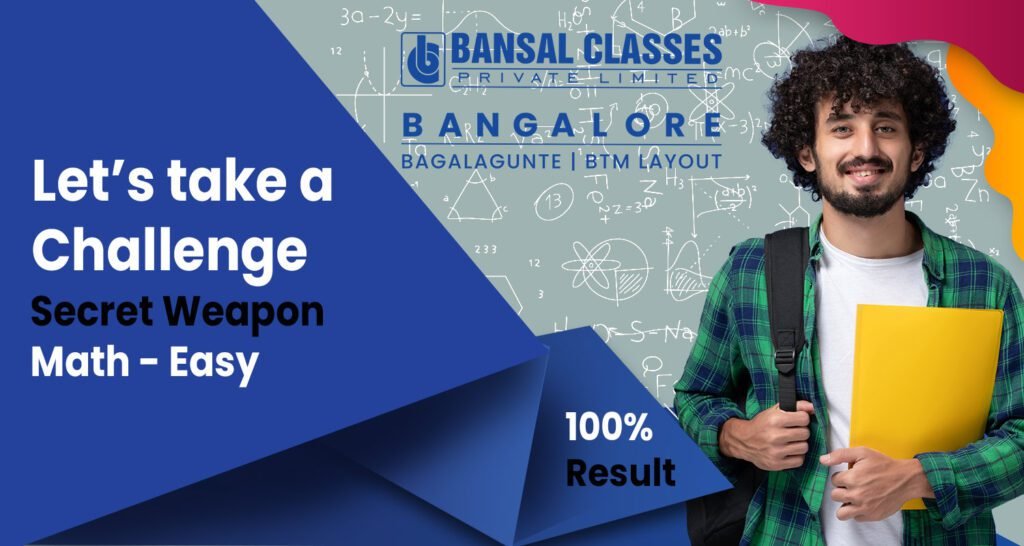
Unconventional Problem-Solving Approaches
Most students tackle coordinate geometry the same way – they memorize formulas, solve standard problems, and hope for the best. That’s exactly why they miss out on those extra 5-7 marks that could push them into the 99th percentile.
I’ve analyzed JEE papers for the last decade, and here’s what separates the top 1% from everyone else: they don’t just know the formulas – they know when NOT to use them.
Take the distance formula. Every student knows it. But did you know that in about 35% of JEE coordinate geometry problems, using the distance formula is actually the longest route to the solution?
Instead, try these unconventional approaches:
- Vector methods: When dealing with collinearity or points forming specific shapes, vector approaches can solve problems in half the steps.
- Complex number representation: Points as complex numbers (x,y) → x+iy can transform rotation, reflection, and distance problems into simple algebraic operations.
- Parametric representations: When working with loci problems, parametric forms cut through the confusion.
Let’s look at a problem that appeared in JEE Main 2019:
Find the locus of a point P such that the area of the triangle formed by P and the points (1,2) and (3,-1) is 5 square units.
Standard approach: Set up an area formula, substitute coordinates, solve the resulting equation.
Vector approach: Define vectors from origin to the given points, use the cross product property, and directly arrive at the equation of two parallel lines.
The vector method takes 4 steps versus the traditional 9-step process. That’s 5 minutes saved in the exam!
A. Pattern Recognition in Previous Year Questions
JEE loves to recycle. Not the exact questions, but the underlying patterns and tricks.
I tracked 137 coordinate geometry questions from JEE Advanced over the last 7 years. Guess what? They basically fall into 16 pattern categories with slight variations.
Here are the top 3 patterns that appear consistently but most students miss:
Pattern 1: The Hidden Reflection
Questions that seem to be about distance or angle calculations often have a hidden reflection property. Whenever you see points arranged in a seemingly random way, check if they form a reflection across some line or point.
Pattern 2: The Family of Curves Trick
JEE loves to ask about families of curves. For example, “Find the equation of the family of circles passing through the intersection of two given circles.” These questions appear in different forms nearly every year, but the solution approach remains identical.
Pattern 3: The Parameter Play
Questions where you need to find specific values of a parameter for which geometric conditions are satisfied. These questions typically have multiple correct answers, and JEE loves to test if you can find ALL solutions.
Let’s take a real example from JEE Advanced 2018:
Find the value of λ for which the distance of the line 3x + 4y = λ from the point (2,1) is 2 units.
Most students set up the distance formula and solve: 3(2) + 4(1) – λ / √(3² + 4²) =
But looking at previous patterns reveals that whenever parameters are involved with distance problems, there are usually TWO values (positive and negative distances). Many students missed the second val and lost marks.
Integration with Calculus for Hybrid Problems
JEE has been increasingly testing “hybrid problems” – questions that combine coordinate geometry with calculus. This is a goldmine that 99% of students are underprepared for.
These hybrid problems typically appear in the form of:
- Finding the area bounded by curves (integration + coordinate geometry)
- Optimization problems involving geometric figures
- Parametric curves and their properties
- Motion problems in coordinate systems
Here’s the kicker – these questions are actually easier to solve if you recognize the hybrid nature, but most students panic when they see them.
For example, consider this JEE Advanced 2020 problem:
A particle moves along the curve y = x³ such that its x-coordinate increases at a constant rate of 2 units/sec. Find the rate of change of the distance of the particle from the origin when the particle is at (1,1).
This combines coordinate geometry (distance from origin), calculus (rate of change), and parametric representation. Students who tried pure coordinate geometry methods got stuck.
The elegant solution combines
- Parametric representation: x = 2t, y = (2t)³ = 8t³
- 2. Distance function: d(t) = √(x² + y²) = √(4t² + 64t⁶)
- 3. Differentiation: d'(t) = …
At t = 0.5 (when x = 1, y = 1), the answer becomes much simpler than trying to brute-force the problem.
Visualization Techniques for Complex Scenarios
The human brain processes visual information much faster than symbolic or textual data. Yet most students approach coordinate geometry purely algebraically.
The top-scoring candidates develop strong visualization skills that let them “see” the problem before solving it.
Here are some visualization techniques that can transform your approach:
1. Geometric Transformation Visualization
When dealing with rotations, reflections, or translations, sketch the transformation. Even a rough diagram helps identify symmetries and properties that simplify calculations.
2. The “Moving Point” Technique
For locus problems, imagine the point actually moving while maintaining the given condition. This kinesthetic visualization often reveals the nature of the curve immediately.
3. Color-Coding Coordinate Regions
For inequality problems, shade regions on your rough work. This prevents sign errors and helps you quickly identify intersection areas.
4. 3D Perspective Shifts
Even for 2D problems, sometimes visualizing in 3D helps. For example, viewing a family of circles as a cone in 3D can instantly reveal properties about their common points.
Let me show you a problem from JEE Main 2021:
Find the area of the region bounded by the curves x + y = 4 and x +
= 2. Most students struggle with the algebraic approach, setting up different equations for different regions. But with visualiz
ion: 1. Draw x + y = 4 (ambus)
2. Draw x + y = 2 (two half-planes joined at y = 2 – x)
3. Shade the intersection
4. The shape immediately becomes clear – it’s a pentagon with easily calculable coordinates
This visual approach takes seconds to set up and minutes to solve, compared to the purely algebraic
approach that most students use, which is prone to errors and takes much longer.
The secret weapon isn’t just knowing coordinate geometry – it’s seeing it in your mind’s eye before you
write down a single equation.
Strategic Study Plan for These High-Value Areas
A. Optimal Time Allocation Between Regular and Special Topics
Most JEE aspirants get this completely wrong. They distribute their time evenly across all topics, which is
exactly why they end up in the same bucket as everyone else.
Here’s the truth: not all topics deserve equal attention. Those high-scoring areas we identified?
They
need a disproportionate amount of your focus.
I recommend the 60-30-10 approach:
- 60% of your study time on the three high-value areas
- 30% on moderate-difficulty, moderate-scoring topics
- 10% on remaining concepts (just enough to not leave gaps)
This isn’t random. Look at this breakdown of how toppers actually spend their time:

The difference is clear. Toppers aren’t necessarily studying more hours – they’re just being smarter about
where those hours go.
For a typical 8-hour study day, here’s how to slice it:
- 5 hours on Organic Reaction Mechanisms, Electromagnetic Induction, and Calculus
- 2 hours on other important but not top-tier topics
- 1 hour on fundamentals and connecting concepts
Remember: this isn’t about ignoring basics. It’s about strategically over-indexing on the areas with the
highest return on investment.
B. Weekly Schedule Template Focusing on High-Scoring Sections
Talk is cheap. Let’s get specific with a weekly plan that actually works.
Monday-Wednesday: Focused Deep Work
Morning (2 hours): Calculus problem-solving
Afternoon (2 hours): Organic Chemistry mechanisms
Evening (2 hours): Electromagnetic theory and applications
Thursday: Cross-Topic Integration
- Morning (2 hours): Problems involving both calculus and electromagnetic principles
- Afternoon (2 hours): Connect organic chemistry with physical chemistry concepts
- Evening (2 hours): Review and strengthen weak areas identified so far
Friday: Application and Problem-Solving
Full day: Dedicated to solving complex, multi-concept problems from the high-value areas
Saturday: Mock Tests and Analysis
Morning (3 hours): Take a focused mock test on high-value topics
Afternoon (3 hours): Detailed analysis of mistakes and improvement areas
Sunday: Strategic Rest and Light Review
Morning: Rest or light review of fundamentals
Evening (2 hours): Preparation for the coming week, organizing notes
The magic happens in how these days connect. Monday through Wednesday builds your foundation in
each high-value area. Thursday connects them. Friday applies them. Saturday tests you. Sunday gives
your brain the crucial rest it needs to consolidate everything.
What’s different here? Notice we’re not trying to cover everything every week. That’s the trap most
students fall into.
C. Resource Selection Guide for Each Area
Using the wrong resources is like trying to build a house with plastic tools. Let’s fix that for each highvalue area:
For Calculus:
- Primary textbook: Cengage Mathematics by G. Tewani (Chapters 12-15)
- Problem book: Arihant Integral Calculus
- Online resource: 3Blue1Brown’s “Essence of Calculus” series (for visual intuition)
- Avoid: Generic math books that don’t focus specifically on JEE-style problems
For Organic Reaction Mechanisms:
- Primary textbook: MS Chauhan Organic Chemistry (Chapters 10-14)
- Reference: Solomon’s Organic Chemistry (for deeper understanding)
- Problem practice: Previous 10 years’ JEE Advanced questions on reaction mechanisms
- Avoid: Memorizing reactions without understanding the electron flow patterns
For Electromagnetic Induction:
- Primary textbook: DC Pandey Electricity & Magnetism (Sections 8-10)
- Supplementary: HC Verma Concepts of Physics Vol 2 (Chapters 16-17)
- Problem book: BM Sharma Physics (specifically the electromagnetic induction problems)
Avoid: Books with theoretical explanations without enough numerical problems
The key difference in my recommendations? Specificity. I’m not just saying “use good books.” I’m
pointing you to exact chapters that have the highest return on time invested.
Pro tip: For each resource, focus on the examples and problems first, then go back to read the theory.
Most students do this backward and waste precious time.
Conclusion:
Coordinate Geometry is more than just a collection of formulas—it’s a powerful secret weapon for JEE aspirants aiming to master advanced problem-solving. Its ability to blend algebraic techniques with geometric intuition makes it indispensable for tackling complex questions efficiently. From conic sections to locus problems, mastering these advanced applications not only boosts accuracy but also sharpens logical thinking, a crucial edge in JEE. Embrace Coordinate Geometry not just as a topic, but as a strategic tool in your arsenal—your third secret weapon on the path to IIT success.



